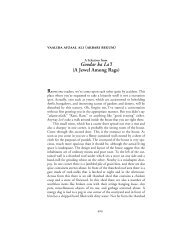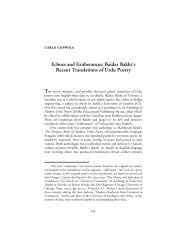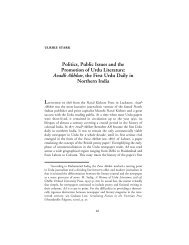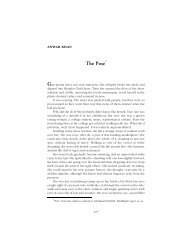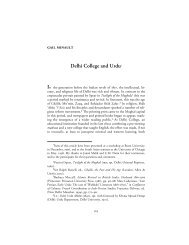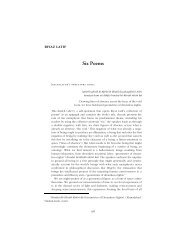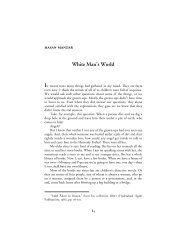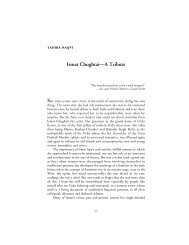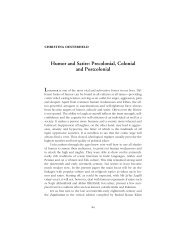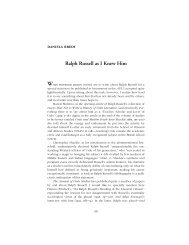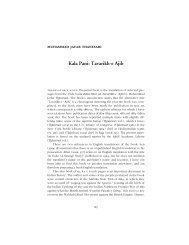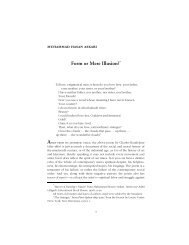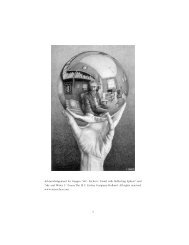Thesis Summary - the Annual of Urdu Studies
Thesis Summary - the Annual of Urdu Studies
Thesis Summary - the Annual of Urdu Studies
You also want an ePaper? Increase the reach of your titles
YUMPU automatically turns print PDFs into web optimized ePapers that Google loves.
252 • THE ANNUAL OF URDU STUDIESPrakashan 1986); Shani, K≥l≥ Jall (Delhi: Akshar Prakashan 1965/NationalPublishing House 1986).In view <strong>of</strong> <strong>the</strong> authors’ openly expressed secular if not irreligious outlookand <strong>the</strong>ir leftist leanings, <strong>the</strong> categorization <strong>of</strong> <strong>the</strong>m as “Muslims”can only refer to <strong>the</strong>ir Muslim family background and cultural affiliation.The writers’ critical intellectual distance, however, is taken to qualify<strong>the</strong>m as important “participant-observers” <strong>of</strong> <strong>the</strong>ir own social and religiouscommunity.The study is divided into six chapters. Chapter 1 serves as an introductionto <strong>the</strong> complex question <strong>of</strong> Muslim identity in India, pointing to<strong>the</strong> fact that Indian Muslims are a heterogeneous and highly diversecommunity. The term “identity” as used here is based on E.H. Erikson’sconcept <strong>of</strong> “subjective experience <strong>of</strong> continuity,” 1 <strong>the</strong> role-and-interactionmodel <strong>of</strong> sociology, 2and Erving G<strong>of</strong>fman’s three-fold typology <strong>of</strong>identity as social, personal and ego identity. 3 The writers are <strong>the</strong>n introduced.Although not viewing <strong>the</strong>mselves as a distinct group, <strong>the</strong>y areunited in challenging <strong>the</strong> distorted picture <strong>of</strong> a Muslim identity definedexclusively on religious grounds. Chapter 2 gives a short summary <strong>of</strong> eachnovel. Chapters 3 and 4 deal with content and <strong>the</strong>mes, focusing on <strong>the</strong>factors that emerge as constitutive features <strong>of</strong> Muslim identity as well ason <strong>the</strong> political, social and economic circumstances that, according to <strong>the</strong>writers, have posed a threat to this identity in <strong>the</strong> recent past. Two mainidentity-related phenomena can be distinguished in <strong>the</strong> novels: an externalmenace to identity due to general developments in Indian society, andan internal process <strong>of</strong> identity change within <strong>the</strong> Muslim community.Hence <strong>the</strong> separation into an outer (ch. 3) and an inner world (ch. 4).Chapter 5 deals with <strong>the</strong> symbolic and metaphorical representation <strong>of</strong>both shattered and preserved identity in four specific novels. Chapter 6 isdevoted to questions <strong>of</strong> literary aes<strong>the</strong>tics and narrative technique, i.e.narrative structure, point <strong>of</strong> view, style and language. Against <strong>the</strong> background<strong>of</strong> <strong>the</strong> Hindi-<strong>Urdu</strong> controversy, <strong>the</strong> section on language combines1 Identity and <strong>the</strong> Life Cycle: Selected Papers, New York 1967 (1959).2 Krappmann, L., Soziologische Dimensionen der Identität. StrukturelleBedingungen für die Teilnahme an Interaktionsprozessen, Stuttgart 1973; Berger, P.L./Luckmann, T., Die gesellschaftliche Konstraktion der Wirklichkeit. Eine Theorieder Wissenssoziologie, Frankfurt a.M., 1980.3 Stigma: Notes on <strong>the</strong> Management <strong>of</strong> Spoiled Identity, Englewood Cliffs,N.Y., 1963.



